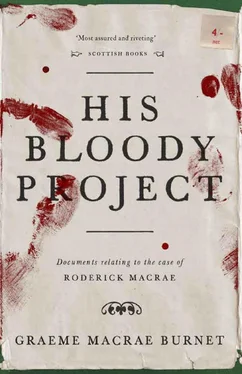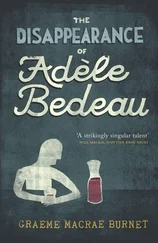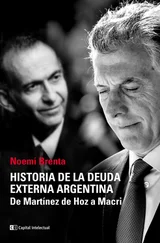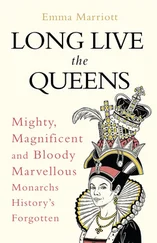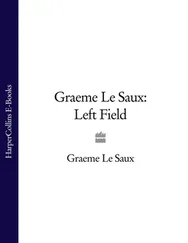Graeme Burnet - His Bloody Project
Здесь есть возможность читать онлайн «Graeme Burnet - His Bloody Project» весь текст электронной книги совершенно бесплатно (целиком полную версию без сокращений). В некоторых случаях можно слушать аудио, скачать через торрент в формате fb2 и присутствует краткое содержание. Год выпуска: 2015, Издательство: Contraband, Жанр: Современная проза, на английском языке. Описание произведения, (предисловие) а так же отзывы посетителей доступны на портале библиотеки ЛибКат.
- Название:His Bloody Project
- Автор:
- Издательство:Contraband
- Жанр:
- Год:2015
- ISBN:нет данных
- Рейтинг книги:5 / 5. Голосов: 1
-
Избранное:Добавить в избранное
- Отзывы:
-
Ваша оценка:
- 100
- 1
- 2
- 3
- 4
- 5
His Bloody Project: краткое содержание, описание и аннотация
Предлагаем к чтению аннотацию, описание, краткое содержание или предисловие (зависит от того, что написал сам автор книги «His Bloody Project»). Если вы не нашли необходимую информацию о книге — напишите в комментариях, мы постараемся отыскать её.
A brutal triple murder in a remote northwestern crofting community in 1869 leads to the arrest of a young man by the name of Roderick Macrae. There’s no question that Macrae is guilty, but the police and courts must uncover what drove him to murder the local village constable.
And who were the other two victims? Ultimately, Macrae’s fate hinges on one key question: is he insane?
His Bloody Project — читать онлайн бесплатно полную книгу (весь текст) целиком
Ниже представлен текст книги, разбитый по страницам. Система сохранения места последней прочитанной страницы, позволяет с удобством читать онлайн бесплатно книгу «His Bloody Project», без необходимости каждый раз заново искать на чём Вы остановились. Поставьте закладку, и сможете в любой момент перейти на страницу, на которой закончили чтение.
Интервал:
Закладка:
As I could see no purpose in prolonging the interview, I stood up and thanked him for his hospitality. Mr M— stood up. He glanced down at the pouch of tobacco which remained on the table between us. His hand darted towards it and he secreted it in the pocket of his jacket. He then looked at us as if nothing had happened. We bade him good day and, with some relief, stepped out into the uncontaminated air of the village.
We neither of us spoke as we walked back towards our ponies. I was conscious that the route we were walking mimicked that of R— M— as he had set out two weeks before on his bloody project. And I wondered if there might have been some inadvertent truth in the crofter’s remark about the difficulty of determining the contents of another man’s mind. Naturally, if a man is in possession of his senses, one need merely ask him, and, assuming the truthfulness of his replies, accept his account of what he might have been thinking at such and such a moment. The problem begins when one is dealing with those who exist in the border-lands of lunacy, and who, by definition, do not have access to the contents of their own minds. It is in order to look inside the minds of such unfortunates that the discipline of psychiatry exists. I have no doubt that Mr Sinclair wished to know the contents of my mind, but not wishing to hasten to an injudicious opinion, for the time being I kept my counsel.
I reflected, as we walked the short distance to the junction of the village, that such a place would seem a kind of paradise to the denizens of our city slums, and, were it not for the sloth and ignorance of its inhabitants, it might be one.
When we reached our ponies, Mr Sinclair expressed the view that it might be beneficial to pay a visit to Mr Mackenzie’s home, which was situated at the other extremity of the village. I could see no purpose in questioning the surviving members of the victims’ family as I was concerned only with the perpetrator, but Mr Sinclair stated that it might aid him in the court-room to familiarise himself with the layout of the scene of the crime. The Mackenzie house was of reasonable construction and appeared well maintained. A stout woman was at the threshold, vigorously working a large churn. She looked up from her labour as we approached. She had a ruddy complexion and thick brown hair, tied up in a bun at the back of her head. Her forearms were rugged and muscular and her general gait and demeanour quite mannish. Nevertheless, she did not exhibit any discernible traits of low breeding and appeared to be a healthy, if unattractive, specimen of the race.
Mr Sinclair, having ascertained that she was the widow of the deceased, offered his condolences and I bowed my head to indicate that I endorsed these sentiments. He informed her that we were concerned with the investigation of her husband’s murder (prudently avoiding mention of his precise role) and asked her if he might step inside for a moment, to ‘acquaint himself with the geography of the house’. The lady indicated with a gesture of her hand that he was welcome to enter, but did not follow us inside. A fire burned at the far end of the room and the temperature was quite oppressive. I stood inside the doorway as Mr Sinclair made a cursory inspection of the premises. The house furnishings made no concession to fashion, but stood, nevertheless, in stark contrast to the hovel we had lately departed. Mr Sinclair’s tour of the chamber took him around the large table where, no doubt, the family took their meals and I fancy he was attempting to reconstruct in his mind the gruesome events which had taken place there. It was only when he reached the far end of the table that his eyes were drawn to an old crone who, despite the heat, was bundled up in blankets in an armchair by the fire. The advocate at once excused himself for the intrusion, but the woman made no response. He repeated his apology in Gaelic, but her watery eyes remained fixed ahead of her and I concluded that she was in an advanced state of dementia.
I stepped outside the house and allowed my associate to complete his inspections in private. Mrs Mackenzie continued her churning, quite as if there was nothing remarkable about the appearance of two gentlemen in this remote shanty. I watched her for some minutes and reflected, as she went about her strenuous and repetitive labour, how little there was to distinguish her from a sheep at the cud. It is a shameful truth that the lower tribes of our country continue to exist in a state barely higher than livestock, deficient in the will to self-improvement which has brought progress to our southern regions.
Mr Sinclair emerged from the house, a light sweat having formed on his brow. He thanked the woman for allowing him to enter her home, then expressed his admiration for her ability to continue her toil in light of the events which had taken place. Mrs Mackenzie looked at him quite blankly.
‘There are still mouths to feed and crops to be taken from the ground, sir,’ she said.
Mr Sinclair nodded at the undeniable truth of this response and we took our leave, both from her and from Culduie, a place to which I shall be content never to return. The day being too far advanced to begin our journey back to Inverness, we returned to the inn at Applecross. I withdrew to my room to compile my notes and reflect on the findings of our excursion, while my associate took advantage of the hospitality below.
The Trial
The following account has been compiled from contemporary newspaper coverage and the volume A Complete Report of the Trial of Roderick John Macrae published by William Kay of Edinburgh in October 1869.
* * * * *
First day
The trial opened at the Circuit Court of Inverness on Monday the 6th of September 1869. At eight o’clock Roderick Macrae was conveyed to the court from his cell in Inverness gaol to a holding room in the basement of the building. He was transported in a windowless carriage, flanked by police horsemen, and the presence of this little convoy in the streets excited great passions among passers-by. According to John Murdoch, covering the case for the Inverness Courier , some who saw it ‘called out offensive words, while others made missiles of whatever came to hand’. Such was the interest in the case that a crowd of several hundred people had gathered outside the court and enterprising vendors had set up stalls to provide for the throng. When the procession arrived, a great cheer went up and the out-riders were unable to prevent the crowd from surging forward and beating the sides of the cab. The carriage was brought to a halt and a number of men were injured as the police fought off the mob with batons. An elderly woman, Mary Patterson, was trampled underfoot and had to be attended by doctors. On subsequent days, barriers were erected and the police presence increased to ensure the safe passage of the convoy.
Special accommodation had been made in the court-room for the large number of reporters wishing to attend the trial and these were admitted by prior arrangement through a side entrance. Admittance to the public gallery was organised by the issue of special hand bills, which, it was later discovered, changed hands for considerable sums of money. By half past nine the public gallery had been filled and the Lord Justice-Clerk Lord Ardmillan and Lord Jerviswoode took their places on the bench. At the bar, the Crown was represented by the Solicitor-General Mr Gifford, a Mr William Crichton and assisted by Mr Gordon Frew, Crown-agent. For the defence, Andrew Sinclair was assisted by his colleague, Edward Smith. The Lord Justice-Clerk began by issuing a stern warning to those in the public gallery. No one would be permitted to enter or leave the court-room during evidence and any person disrupting the proceedings would be peremptorily ejected and their bill of admission confiscated.
Читать дальшеИнтервал:
Закладка:
Похожие книги на «His Bloody Project»
Представляем Вашему вниманию похожие книги на «His Bloody Project» списком для выбора. Мы отобрали схожую по названию и смыслу литературу в надежде предоставить читателям больше вариантов отыскать новые, интересные, ещё непрочитанные произведения.
Обсуждение, отзывы о книге «His Bloody Project» и просто собственные мнения читателей. Оставьте ваши комментарии, напишите, что Вы думаете о произведении, его смысле или главных героях. Укажите что конкретно понравилось, а что нет, и почему Вы так считаете.
